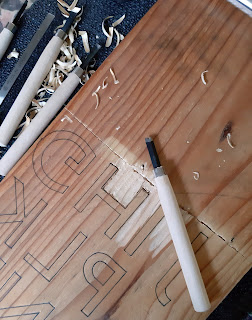When lockdown began in March, along with many others, I found myself without access to a lot of the equipment and studio facilities I'd previously been lucky enough to enjoy.
I'd begun to experiment with letterpress as part of my MA, using an eagle press and letterpress blocks in my university print studio, so when both suddenly became unavailable a solution needed to be found!
Once lockdown had commenced, I found myself in rural Northumberland with an abundance of two things at my disposal: wood and time. Add an enthusiastic and knowledgeable craftsman dad into the mix and I started to feel more optimistic. I was going to make my own blocks and hand burnish my prints.
During April and May, I created my own letterpress blocks. I'm documenting the process below - I hope it might prove useful to others interested in the technique.
 |


I had a block of Japanese Katsura to hand, so I began by printing my letters (Gill sans) on tracing paper and transfered them to the block using graphite before carving. (Be sure to reverse your letters at this stage - or they print backwards!) I stained the block yellow to make seeing my carving process clearer.
After lockdown, I had real trouble sourcing the katsura I had used for the first six blocks. So I transferred the remaining letters to an old pine plank. At the very least I hoped comparing the two types of wood would make for interesting results. I carved all of the letters and then divided the block after the carving was completed (below)
After dividing the block, I sanded each letter. The pine had a tendency to splinter, so real care had to be taken when using the saw. All in all, the above process took me around three days in total.
So, on to the results...
The completed blocks Comparing the Katsura (B) with the pine (K)
And the full printed alphabet:
Findings:
- Pine is softer than Katsura - this is visible in the above print, where you can see the letters A-F are cleaner than the following letterforms.
- This softness made the carving process more challenging and ultimately, resulted in more visible imperfections in the final letters.
- The blocks are all of unequal size - something I should have considered prior to carving. For my next attempt, I'm going to measure and place the letters more carefully to ensure the finished blocks are uniform in size and therefore easier to print.
Ultimately, I was happy with this first attempt and I was eager to follow up on it by creating a second set, putting the above knowledge to good use. In the following post I will document the process of creating the second set of letters.












No comments:
Post a Comment